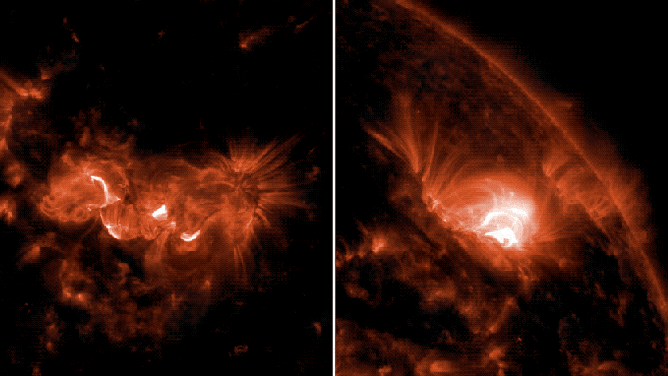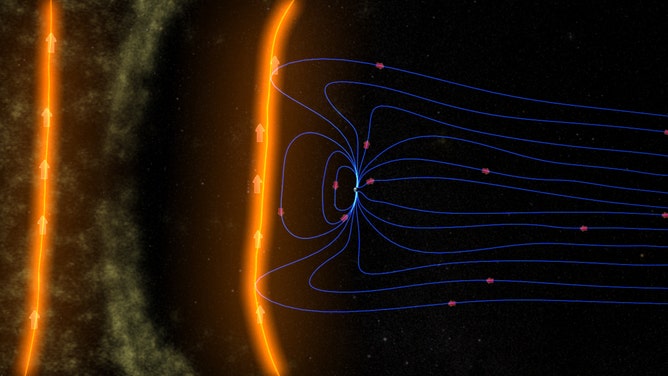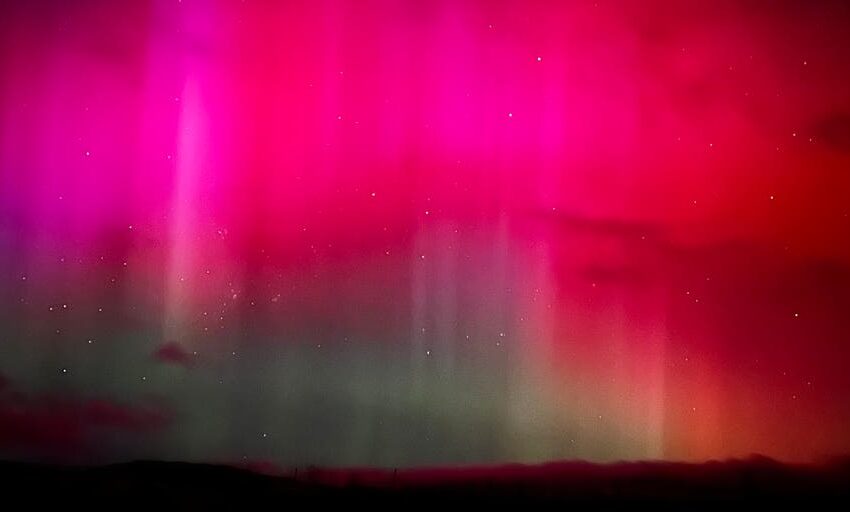Space weather experts say the aurora is being spotted further south in Northern Hemisphere than is typical with many chances to see stunning displays of lights over the weekend.
The first of what could be several geomagnetic storms impacted the globe on Friday, raising hopes for a dazzling display of the Northern Lights, while also putting infrastructure operators on guard for potential electrical effects from the solar event.
The SWPC says satellites observed conditions that reached level 5 on their 5-point scale of geomagnetic activity on Friday evening.
Geomagnetic storms can impact infrastructure in near-Earth orbit and on Earth’s surface, potentially disrupting communications, the electric power grid, navigation, radio and satellite operations, the SWPC says.
“We have notified all of our infrastructure operators that we coordinate with, such as satellite operators, communication folks, and of course, the power grid here in North America,” said SWPC coordinator Shawn Dahl. “So they are able and prepared to take mitigation efforts as much as possible throughout this event if it should unfold to the levels that we currently are anticipating.”
NOAA space weather forecasters have observed at least seven coronal mass ejections (CMEs) from the sun, with the first impacts arriving early Friday afternoon ET. Heightened solar conditions are expected to persist perhaps as long as Sunday.

(FOX Weather)
But most notable from strong geomagnetic events are brilliant displays of the Northern Lights that may reach much farther south than typical displays. The SWPC says that if the storm reaches predicted levels, the aurora could be seen as far south as Alabama and Northern California.
“This is an unusual and potentially historic event,” the SPWC said Friday.
THE HISTORY OF EARTH’S GREATEST SOLAR STORMS
Already, skies lit up in incredible hues of bright red, pink and purple in New Zealand as the first waves of the storm arrived during darkness.
On Thursday, the SPWC issued its first “severe” Geomagnetic Storm Watch since January 2005 and said the event was the most powerful since the Halloween 2003. The solar event led to power outages in Sweden and electrical grid damage in South Africa.
Sunspots merged
Two massive sunspots have recently merged and spit out at least two X-class (largest) and several M-class (second-largest) solar flares. According to NOAA, the explosive acceleration of charged and superheated plasma, known as a coronal mass ejection or CME, speeds through space and expands.
The new sunspot is 16 times the diameter of the Earth.

NASA’s Solar Dynamics Observatory captured these images of the solar flares — as seen in the bright flashes in the left image (May 8 flare) and the right image (May 7 flare). The image shows a subset of extreme ultraviolet light that highlights the extremely hot material in flares and which is colorized in orange.
(NASA/SDO / NOAA)
Another sunspot also released strong CMEs this week and continues to be active. According to NOAA, the bulk of five CMEs will collide with Earth in a glancing blow as early as midday Friday through Sunday.
“These two sunspot clusters are magnetically complex and much larger than Earth. Together they have been the source of frequent M-class flares (minor to moderate),” stated the Space Weather Prediction Center. “RGN 3664 (the combined sunspot region) continues to grow and increase in magnetic complexity and has evolved into a higher threat of increased solar flare risk.”
How flares can set off geomagnetic storms
“Flares are when the sun brightens, and we see the radiation, and that’s kind of the muzzle flash,” explained Professor Peter Becker of George Mason University in an earlier interview. “And then the cannon shot is the coronal mass ejection (CME). So, we can see the flash, but then the coronal mass ejection can go off in some random direction in space, but we can tell when they’re actually going to head towards Earth. And that gives us about 18 hours of warning, maybe 24 hours of warning, before those particles actually get to Earth and start messing with Earth’s magnetic field.”
SOLAR SUPERSTORM COULD ‘WIPE OUT THE INTERNET’ FOR WEEKS OR MONTHS, SCIENTIST SAYS

An illustration of Earth’s magnetic field shielding our planet from solar particles.
(NASA/GSFC/SVS / NASA)
NOAA warns of a wide area blackout of high frequency radio communications for hours. The geomagnetic storm could also cause widespread voltage irregularities in power systems which trigger false alarms on security devices, cause drag on low earth orbit satellites preventing them from orienting and cause range errors and a loss-of-lock for GPS systems.
Forecast: Will clouds block my aurora viewing?
With current forecasts, this storm may strike Earth late Friday into Saturday morning across North America.
The FOX Forecast Center said the skies look clear for most of the northern U.S. with less than 10% cloud cover expected from the Midwest to the Northwest. However, clouds will be around in the Northeast.
Forecasters estimate these conditions occur for about 60 days over an 11-year solar cycle.

Aurora cloud cover forecast for Saturday morning (5/11)
(FOX Weather)
NOAA says scientists have only observed three Severe geomagnetic storms since the current solar cycle started in December 2019.
“The last (observed) Severe geomagnetic storm was on March 23, 2024, and the last Extreme was the Halloween Storms in October 2003,” the SWPC stated. “That G5 (Extreme storm) resulted in power outages in Sweden and damaged power transformers in South Africa.”
X-class solar flares are the largest explosions in the solar system. According to NASA, the biggest X-class flares can produce as much energy as 1 billion atomic bombs. M-class are the second-strongest flares that can cause minor radiation storms and can harm astronauts.
The solar cycle is peaking making solar storms more plentiful
Tree rings and ice cores are evidence of much larger solar superstorms in the past.
In 1859, the great Carrington Event, generally regarded as Earth’s greatest solar storm in recent history, covered nearly the entire planet in aurora. About 14,000 years ago, a solar flare, possibly hundreds of times stronger than the Carrington flare, impacted Earth.
NOAA forecasts the current 11-year solar cycle to peak sometime in 2024 or early 2025 and solar activity is likely to remain active for the next several months or even few years.
NOAA PREDICTS STRONGER PEAK OF SOLAR ACTIVITY IN 2024 THAN ORIGINALLY ANTICIPATED







